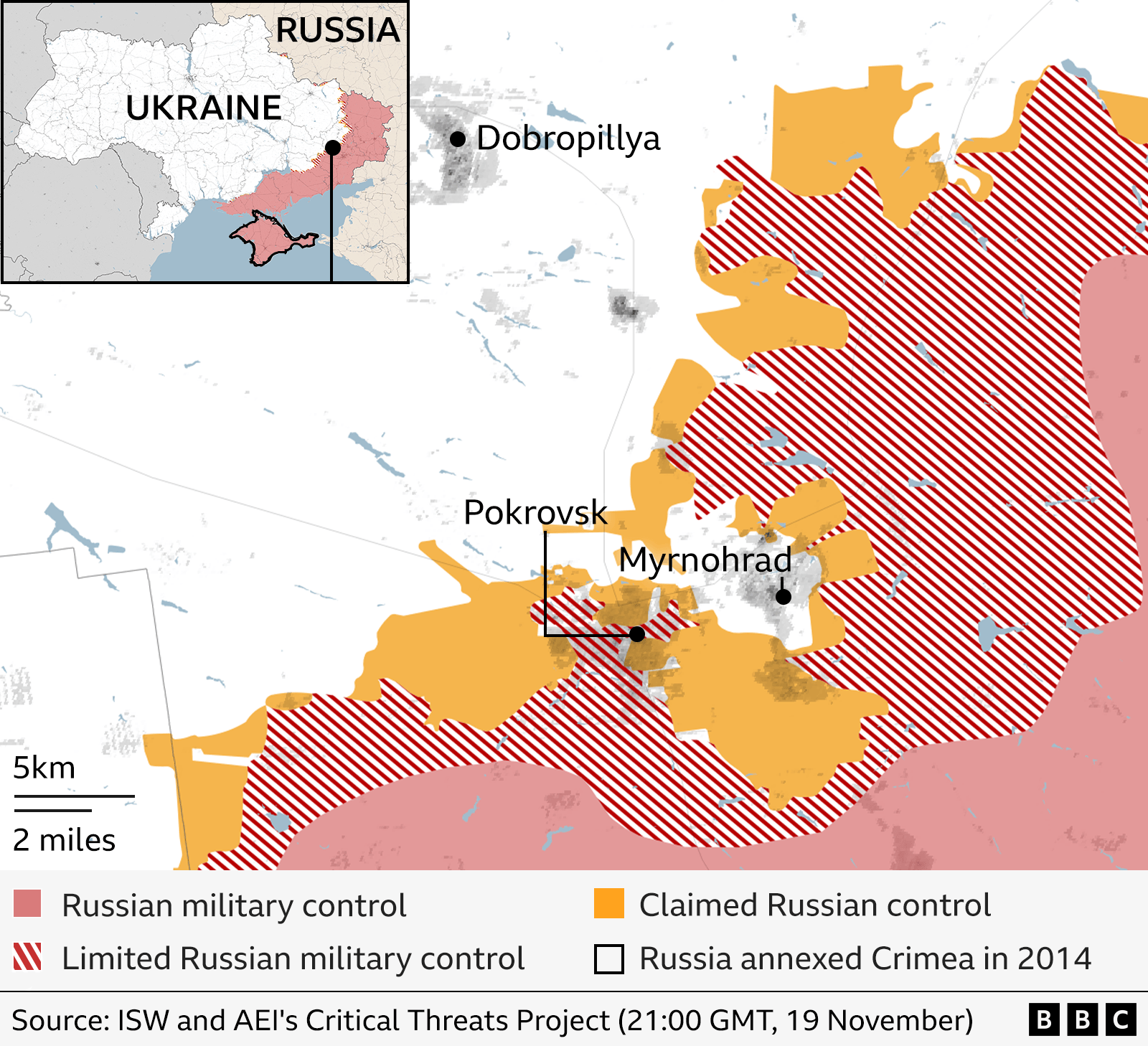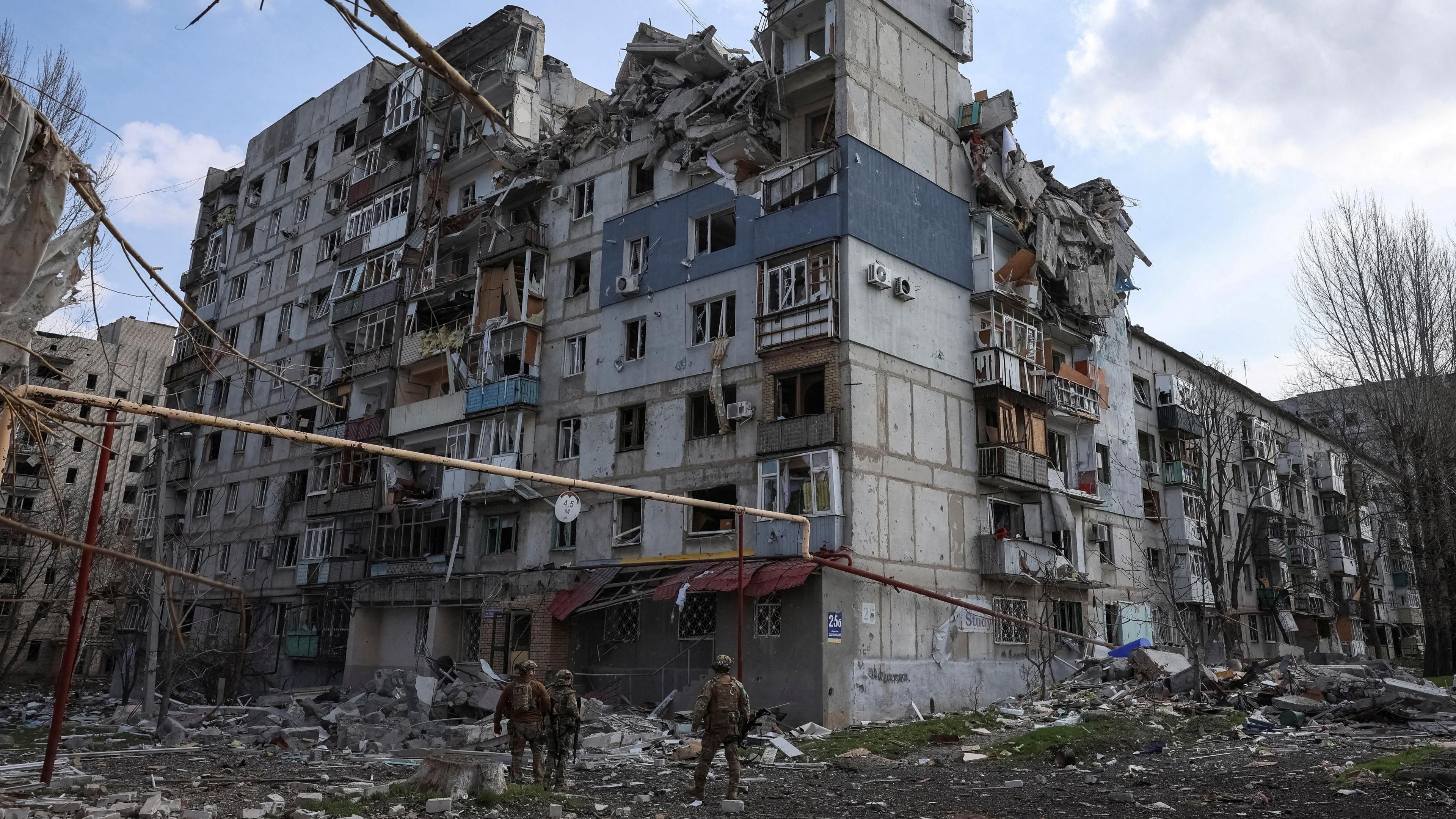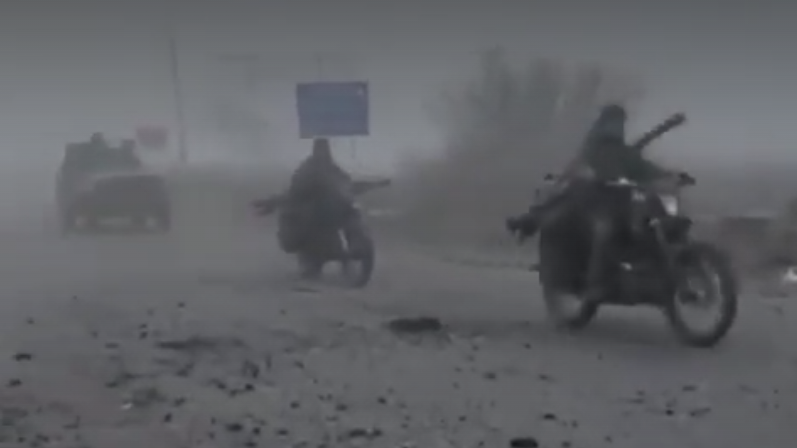In Ukraine's 'kill-zone', robots are a lifeline to troops trapped on perilous eastern front
A robot being sent on a mission by Ukraine's fifth brigade to deliver supplies to troops on the frontline
- Published
"The toy is delivered," a Ukrainian soldier whispers into the radio.
In the dead of night, he and his partner move quickly to roll out their cargo from a van. Speed is crucial as they are within the range of deadly Russian drones.
The fifth brigade's new "toy" is an unmanned ground vehicle (UGV), a robot that provides a lifeline for Ukrainian troops at the front in Pokrovsk and Myrnograd, a strategic hub in eastern Ukraine.
Russian forces are relentlessly trying to cut off Ukraine's supply routes in the area.
Without fresh food and ammunition, Ukraine's frontline soldiers would face a choice of either surrender or a costly retreat.
Kyiv has sent special forces, elite assault units and drone groups to reinforce its troops in and around Pokrovsk, but Russia's grip on routes into the city means going in with armoured vehicles would bring almost certain death.
Transporting heavy supplies on foot would be just as dangerous.
This is where the robot, also known as a land drone, comes in place of traditional troop deployments.
The battle of Pokrovsk will probably go down in history as the first in which unmanned ground vehicles were used on a mass scale, largely to deliver supplies and evacuate wounded.
The robot is small enough to squeeze into a bicycle lane and looks like a mini tank without a turret.
UGVs are difficult to spot, they are harder to jam than an aerial drone and, most importantly, soldiers can operate them remotely from a safer location.
They save soldiers' lives and are the future of the army, according to Ihor, the head of unmanned systems for the 7th Corps of the Ukrainian army.
About 90% of all supplies for Pokrovsk frontline are now delivered by UGVs, he says.

Meanwhile, Russian forces are trying to capture the city by choking the supply chains and relentlessly launching remote-controlled drones to target anything that moves in what is widely called "the kill-zone".
This 30km-wide stretch of territory along the frontline is within reach of drones from both sides.
Constant aerial reconnaissance means any movement in the kill-zone is quickly detected and attacked, by drones as well as conventional weapons such as artillery, mortar rounds and aerial bombs.
It's a situation that military doctor Vitsik and his land drone operator Auditor know only too well. These are their call signs, not their real names.
When they tried to evacuate wounded Ukrainian soldiers from Pokrovsk last month they were quickly spotted and had only seconds to rush to a nearby house to escape the buzz of Russian drones.
"One drone after another attacked us," Vitsik recalls. "As soon as the drone hit the ground and exploded, immediately the next one appeared. They also fired from artillery and mortars trying to kill us."
The walls Vitsik and Auditor hid behind shook with each explosion. The barrage lasted for 59 minutes and they eventually slipped into a neighbouring building and escaped.
Inside Pokrovsk the drone threat from above is ever present.
"We run from one bush to another, from one house to another, from one street to another," says Vitsik.

Combat medic 'Vitsik' was caught up in an almost hour long drone attack in the "kill-zone" when attempting to evacuate the wounded
Thanks to those "first-person view" drones, Russian troops are close to cutting off all routes leading to Pokrovsk.
They claim to have surrounded the entire area, but Kyiv has repeatedly denied that.
The head of Ukraine's HUR intelligence agency, Kyrylo Budanov, has told local media the situation in Pokrovsk is "extremely difficult" but Ukraine is "still holding on there".
And yet moving troops into and around the city is extremely dangerous and Ukrainian forces have tried to limit rotating people in and out due to the high risks.
As a result, soldiers remain in frontline positions for weeks, sometimes even months.
It has made delivering supplies an even more pressing task, and that means the demand for unmanned ground vehicles is growing.
A single unit of the 5th brigade can carry out several logistical missions with UGVs in one day.
Each assignment starts in an old, shabby garage and the mission I watch is delivering water, ammunition and fuel to drone pilots.

Pokrovsk is largely deserted but as a key road and rail junction, it is essential for Ukraine to keep the city from Russian control
Supplies are loaded on a land drone called Termit, capable of carrying about 200kg. The operator drives it by remote control into the back of a van which takes it closer to the frontline to preserve its battery.
When it is dark, two soldiers jump out of the van and roll out the UGV.
One of them informs the control room via radio that the land drone has been offloaded.
Within seconds the operator several kilometres away confirms he is connected to the machine and Termit heads off to its destination.
Machines like Termit have been used by some Ukrainian brigades since last year but they have become increasingly popular in recent months.
At a workshop for the 79th brigade, engineers who previously made only aerial remote-controlled drones are now tasked with upgrading unmanned ground vehicles for use in combat zones.
They apply camouflage, weld new platforms and add hardware for extra communication. But even with these improvements, UGVs are still vulnerable to drone attacks.

Engineers are increasingly tasked to make the land drones combat zone ready adding camouflage and extra communication links
"No matter how well it is concealed, no matter what connection you use and how quickly it moves", the machine can still be detected and destroyed, says a UGV operator with the call sign "Lawyer".
During one mission to evacuate a wounded soldier from Pokrovsk, his unmanned vehicle hit a landmine damaging its tracks.
Another land drone was sent on a rescue mission from a different unit, but it was destroyed too. Lawyer still does not know if the wounded soldier made it out alive.
On average just one out of three UGVs manages to reach the city, says Ihor, from the unmanned systems department of the 7th Corps.
While the majority of the small robots won't make it, the troops on the frontline are reliant on those that do.
Related topics
- Published6 November

- Published12 November
